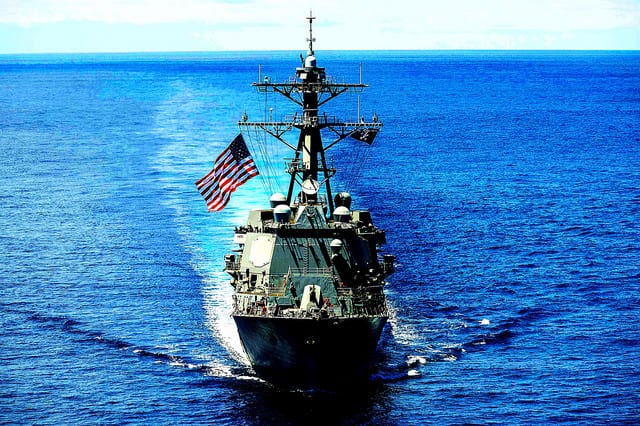 Image Courtesy of Stuart Rankin on Flickr.
Image Courtesy of Stuart Rankin on Flickr.
Chinese Escalation in the South China Sea
A Chinese Destroyer recently came dangerously close to an American Navy ship during a “Freedom of Navigation” patrol near a Chinese-occupied reef in the contested South China Sea. Over the past several months the Chinese government has increased aggression toward its neighbors and US Navy ships patrolling the area. In addition to increased aggression, the Chinese government has built several man-made military bases on top of arcs of shallow reef islands populated by tropical marine life in the South China Sea. Considering that the world has a over 5 trillion dollars invested in trade flow in the South China Sea, an increased military escalation could cause the regional powers to enter into a conflict that could potentially cost more than they bargain for.
The Philippines, Japan, Vietnam, and South Korea all rely substantially on trade routes in the South China Sea. Currently, 5.3 Trillion dollars in total global trade travels through the region each year along with 11 billion barrels of oil, and 190 trillion cubic feet of natural gas. Increased Chinese aggression puts more stress on trade routes and ports in China and throughout Southern Asia. It is projected that 90% of Middle Eastern fossil fuel exports will to go to Asia by 2035, giving control of vital shipping routes to China in the contested region. A military conflict in the South China Sea could destabilize current geopolitical ties and precipitate a world economic crisis that could lead to an all-out war. China itself relies on the South China sea for nearly 40% of its total trade. It is possible that this is why the bases are being constructed, however, an increase in military presence in one of the world’s major trade routes could imperil future trade and the stability of the area.
Today, China claims 90% of the South China Sea, much of which is contested by both the Philippines and Vietnam. Brunei and Malaysia also claim maritime territory in the South China Sea. These claims have led to the increasing of defense budgets of all countries involved and escalated the geopolitical militarization in the region. In a visit to the Southern Theatre Command, the Chinese President Xi Jinping ordered maritime troops there to increase their readiness drills and prepare for war. He stressed to the commanders China’s need to build a force that can “fight and win wars.” This kind of rhetoric could cause a relatively small incident, such as a Chinese destroyer coming dangerously close to a US Navy ship, to escalate to an all-out war in the region.
Territory in the South China Sea has been contested for over a century, however, the creation of these bases displays a shift in Chinese strategy in the region. The Paracel, and Spratly Islands, make up two of the most disputed island chains. The Chinese government claims that its ‘infrastructure projects’ in the region are strictly for civilian use only, but its island development has profound security implications. This hasn’t been the first time that the Chinese have transformed these small shoals; however, China’s introduction of military technology to these miniature ports is a new development. Earlier in 2018, China installed anti-ship cruise missiles and surface-to-air missile systems on three outposts in the South China Sea. These missile systems greatly increase China’s military capability in the area, further escalating tensions between regional governments and trade partners.
Runways, support buildings, loading piers, and possible satellite communication antennas are some of the other infrastructure projects being constructed in the South China Sea. The creation of these island bases causes the US and China’s neighbors to question what they are truly being used for. These countries argue that they drastically increase China’s power projection capabilities in the region.
A greater effort for improved diplomatic ties between China, the US, and its neighboring countries must be made to ease tensions in the region. A solution to the South China Sea dispute will not be found after the swells calm, but rather beforehand at the negotiation table, where all parties should come together and resolve the dispute peacefully.





